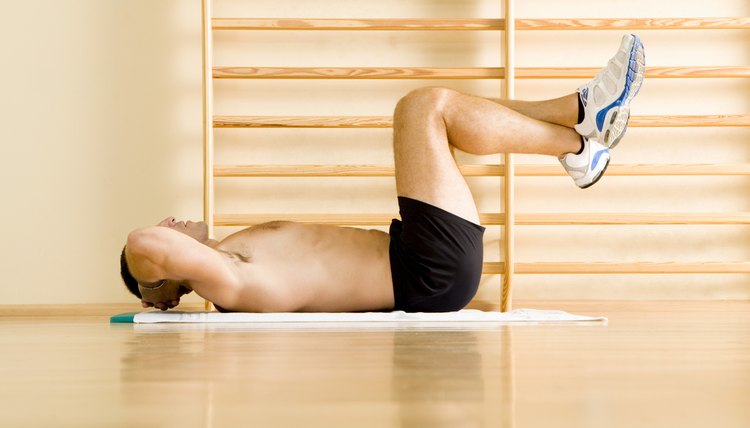How to Perform a Reverse Crunch Without Hurting the Lower Back

Lower-back pain is a common complaint and one that should not be aggravated by exercise. Strong abdominal muscles support the lower back, so a variety of exercises are used to enhance the core. One of these exercises, the reverse crunch, is an effective core strengthener, which according to the IDEA Health and Fitness Association, activates slightly more intense lower-abdominal muscle activity than a traditional crunch. The reverse crunch, if performed with proper form, will not aggravate a sensitive lower back. Always seek the advice of your doctor before beginning any exercise program or if you continue to experience back discomfort.
Abdominal Muscles
The muscles in your stomach include the transverse abdominis, the rectus abdominis and the internal and external obliques. When you perform a reverse crunch, the rectus abdominis, which runs the center length of your stomach, and the external obliques, which are located on your sides, are active. Abdominal muscle strength and endurance protect the back from discomfort by stabilizing the trunk.
Supine Reverse Crunch
Lie face up to begin the reverse crunch. Bend your knees and place your feet on the floor. Straighten your arms to the sides in line with your shoulders and face your palms toward the floor. Tighten your stomach by pulling your navel toward your spine. Exhale as you raise your feet and align your knees over your hips. Keep your knees bent at a 90-degree angle. Breathe normally and press your lower back into the floor. Exhale and raise your hips off the floor as your knees move closer to your chest. Inhale and return to the starting position. Keep your knees over your hips, which will reduce stress on your lower back.
Stability Ball
A reverse crunch with a stability ball helps keep the knees and hips aligned, which prevents stress on the lower back. An exercise stability ball is a large, inflatable ball used for various exercises. During the reverse crunch, place the ball behind your knees between the backs of your legs. Rest your calves on top of the ball and hold the ball tightly against the backs of your upper legs. Exhale and raise your knees toward your chest. Inhale and return to starting position.
Advanced
As your abdominal strength progresses, an advanced reverse crunch continues to improve your strength. Lie face up on the floor with your knees bent at a 90-degree angle and your feet off the floor. Exhale, lift your hips off the floor and extend your straight legs toward the ceiling. Inhale, lower your hips, bend your knees and return to start position. Another way to increase the resistance with a reverse crunch is with the use of a weighted medicine ball. Lie face up with your knees bent and your feet flat on the floor. Place a medicine ball between your knees. Lift your feet off the floor to align your knees with your hips. Exhale and bring your knees toward your chest lifting your hips off the floor. Inhale and return to starting position. If you experience lower-back discomfort, discontinue these versions of the reverse crunch.
References
- American Council on Exercise: Supine Reverse Crunches
- PhysioAdvisor: Abdominal Strengthening Exercises
- Core Performance: Stability Ball Reverse Crunch
- IDEA Health and Fitness Association: Muscle Activity and Body Position
- Dr. Len Kravitz: Fitness and Low Back Pain
- Sports Injury Clinic: Medicine Ball Reverse Crunch
Writer Bio
A mother of two and passionate fitness presenter, Lisa M. Wolfe had her first fitness article published in 2001. She is the author of six fitness books and holds an Associate of Arts in exercise science from Oakland Community College. When not writing, Wolfe is hula-hooping, kayaking, walking or cycling.
